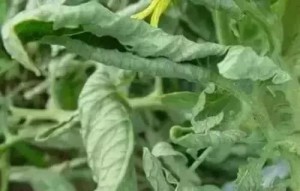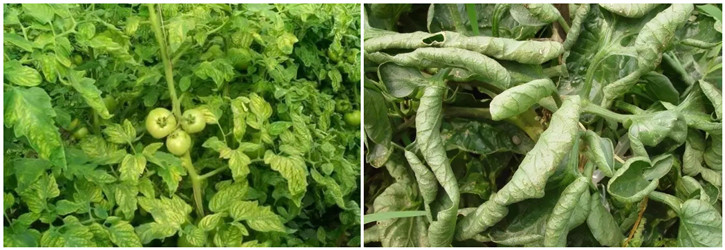Causes of leaf roll up
1. High temperature, drought and water shortage
If the crops encounter high temperature (the temperature continues to exceed 35 degrees) and dry weather during the growth process and cannot replenish water in time, the leaves will roll up.
During the growth process, due to the large leaf area, the dual effects of high temperature and strong light enhance the leaf transpiration of the crop, and the speed of leaf transpiration is greater than the speed of water absorption and transfer by the root system, which can easily cause the plant to be in a state of water shortage, thereby causing The leaf stomata are forced to close, the leaf surface is dehydrated, and the lower leaves of the plant tend to curl upwards.
2. Ventilation problems
When the temperature difference between the inside and outside of the shed is large, if the wind is suddenly released, the exchange of cold and warm air inside and outside the shed is relatively strong, which will cause the vegetable leaves in the shed to roll up. In the seedling stage, it is particularly obvious that the ventilation in the shed is too fast, and the exchange of outdoor cold air and indoor warm air is strong, which can easily cause the curling of vegetable leaves near the ventilation openings. This kind of upward rolling of leaves caused by ventilation generally starts from the tip of the leaf, and the leaf is in the shape of chicken feet, and the dry tip has a white edge in severe cases.
3. The problem of drug damage
As the temperature rises, especially in summer, when the temperature is relatively high, phytotoxicity will occur if you are not careful when spraying. . For example, the phytotoxicity caused by the improper use of hormone 2,4-D will lead to bending of leaves or growing points, new leaves cannot be unfolded normally, leaf edges are twisted and deformed, stems and vines are raised, and the color becomes lighter.
4. Excessive fertilization
If the crop uses too much fertilizer, the concentration of the soil solution in the root system will increase, which will hinder the absorption of water by the root system, so that the leaves will become water-deficient, causing the leaflets to turn over and roll up.
For example, when too much ammonium nitrogen fertilizer is applied in the soil, the middle ribs of the small leaves on the mature leaves are raised, the leaflets show a reversed bottom shape, and the leaves turn up and roll up.
Especially in saline-alkali areas, when the salt concentration of the soil solution is high, the phenomenon of leaf curling up is more likely to occur.
5. Deficiency
When the plant is seriously deficient in phosphorus, potassium, sulfur, calcium, copper, and some trace elements, it can cause leaf rolling symptoms. These are physiological leaf curls, which are often distributed on the leaves of the entire plant, without the symptoms of bright vein mosaic, and often occur on the leaves of the entire plant.
6. Improper field management
When vegetables are topped too early or crops are pruned too early and too heavy. If vegetables are topped too early, it is easy to breed axillary buds, resulting in nowhere for the phosphoric acid in the vegetable leaves to be transported, resulting in the first aging of the lower leaves and the curling of the leaves. If the crops are forked too early and pruned too much, it will not only affect the development of the underground root system, limit the quantity and quality of the root system, but also make the aboveground parts grow poorly, affect the normal growth and development of leaves, and induce leaf rolling.
7. Disease
Viruses are generally spread by aphids and whiteflies. When a virus disease occurs in a plant, all or part of the leaves will curl upward from top to bottom, and at the same time, the leaves will appear chlorotic, shrinking, shrinking, and clustering. and upper leaves.
In the later stage of leaf mold disease, the leaves will gradually curl from bottom to top, and the leaves at the lower part of the diseased plant will first become infected, and then gradually spread upward, making the leaves of the plant yellow-brown and dry.
Post time: Nov-14-2022









